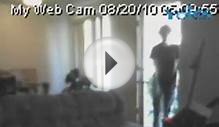
Then you need some software which can record the feed from a webcam either continuously or – more usually – when motion is detected. There are good free applications, such as iSpy Connect, as well as paid-for software such as SightHound (formerly Vitamin D)
When you install the software, it should provide a list of connected webcams, and may support multiple cameras. You can then configure ‘zones’ which are rectangular areas within the webcam’s view which will be used for detecting motion.
You might select your baby’s cot, a cat flap or door, or the space where you park your car. You want to avoid including objects that move, such as trees swaying in the wind or passing traffic. Otherwise you’ll end up with too much footage to review.
Good software will provide a playback console which shows recorded clips on a timeline so you can quickly watch clips recorded when movement was detected. Depending on the software, there might be options to send an email (along with a jpg image) or a text message when motion is detected, upload the clip to YouTube or an FTP server, or even play a recorded message, such as you telling your dog to stop barking (iSpy can be configured to respond to audio triggers as well as motion).
It’s worth trialling a webcam for security or home monitoring before investing in an IP camera since it needn’t cost you a penny if you already have a webcam.
The downsides to using a webcam is that you’ll need to leave your PC on constantly, which could make for an expensive electricity bill as well as the potential shortening of your PC’s life, especially if it gets hot after running for long periods.
Another issue is that your PC may not be near the spot you want to monitor, and USB extension cables will get you only so far.
Finally, if you place a webcam facing out of a window, you may get reflections at different times of the day as the sun’s position changes. Plus, the vast majority of webcams will be useless at night unless there’s good street lighting or – if you’re monitoring indoors – you keep a light on.
The advantage of using an IP camera instead of a webcam is that you won’t need to leave a computer running. The IP stands for Internet Protocol, and essentially means that they connect to your router (usually via Wi-Fi) and therefore can be mounted anywhere in Wi-Fi range where there’s a power source.As they connect to your router, you can view the real-time footage from any computer on your home network (or a smartphone or tablet if it works in their web browser or has a dedicated app). As with webcams, you can install software on a PC to record footage when motion is detected, but it’s better to opt for a camera with a microSD card slot for recording footage. You won’t need to remove the card to view the footage: it should be possible to do this via a web browser or dedicated app or Windows software.
Features to look for include infrared night vision, which will record lower quality but usable footage in almost complete darkness. You may also want one with all-weather housing that won’t be damaged by rain if mounted outdoors. Finally, pan, tilt and zoom (PTZ) cameras allow you to remotely adjust where the camera is pointing and zoom in to see more detail.
The cheapest IP cameras (around £60) may not have HD resolutions, and it’s well worth spending extra for better image quality, rather than opting for a cheap PTZ camera with poor image quality.
RELATED VIDEO











